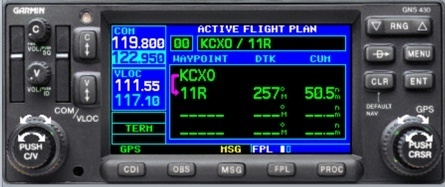Shana Bartell
Direct-To or Flight Plan?

Do you know the difference between navigating using Direct-To versus navigating with a Flight Plan while using your Garmin GPS?
Let’s summarize the function of each:
Direct-To = Present position direct to the active waypoint.
Flight Plan = Point A to Point B
When you are setting up your Garmin GPS, you likely use one of these methods to navigate to your destination.
Direct-To
(Present Position)———(Point B)
If you are a Direct-To-kind-of-pilot, you probably like the simplicity of pressing one key, entering your destination airport, pressing ENTER ENTER and being on your way. This works great for VFR flying with a straight-line route to your destination.
Flight Plan
(Point A)———(Point B)
If you are a Flight-Plan-kind-of-pilot (like myself), you probably like the ability to add multiple waypoints and varying routes by pressing the FPL key, entering in the details and having your full route available. Setting up the Flight Plan is a MUST for IFR flying if you want to take advantage of Garmin’s features.
Which one is best?
While both methods can work okay for some scenarios, I recommend using the Flight Plan method for most flights, even if you plan on flying “Direct”. The benefit of Flight Plan is that you not only have a defined destination, but also a defined departure airport. In addition, the defined route is a distinct route from an exact waypoint to another exact waypoint rather than from the less specific “present position” where you activated the “direct-to” function.
Even for VFR flying, I still recommend using the Flight Plan. Why? Because it takes no extra effort, yet provides added benefits. Surprisingly it takes the same number of button presses to use Flight Plan as it does Direct-To. When you turn on the avionics, your Garmin GPS will find it’s position and automatically put the departure airport in the first line of the Flight Plan. This means all you have to do is press FPL, enter your destination (and route, if applicable), and then press ENTER. Takes the same amount effort but builds good habits.
There are certainly times when you will use the Direct-To key… I want you to think of the Direct-To key as the “Diversion Key” to be used when deviating from the original plan. For instance, when ATC clears you direct to a waypoint along your route, this is an appropriate time to use the Direct-To key. If you need to divert to a nearby airport, that is an appropriate time to use the direct-to key.
The Small Magenta Arrow in the Flight Plan
Have you ever noticed the subtle magenta (pink) arrow in the Flight Plan to the left of the screen? This small arrow is very important in understanding what’s going on in the brain of your Garmin GPS.
![]()
If it is an arrow from one waypoint to the next. it indicates a flight plan leg between those two specific waypoints. This is the normal indication as the flight plan progresses past the waypoints.

If it is a single arrow to a waypoint, it means you are navigating “Direct-To” that waypoint. That means your CDI (course deviation indicator) is drawing a course from the position where Direct-To was activated to the waypoint in the flight plan.

After it reaches the waypoint, it begins progressing between flight plan waypoints again as described above. This is somewhat of a hybrid between the “Direct-To” and “Flight Plan” methods that occurs when you select direct-to a waypoint in your flight plan.

Summary
In conclusion, I would recommend using Flight Plan as your primary method of GPS navigation, and use Direct-To as needed for deviations to the plan. VFR pilots might not think this is important, but it will form good habits that translate to the IFR world later.
Would you like more information?
Send us a message below.

